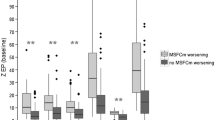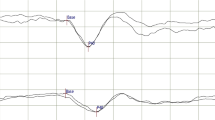Abstract
Evoked potentials (EPs) have long been used as diagnostic tools in multiple sclerosis (MS), although their importance decreased as magnetic resonance imaging (MRI) became available. However, the prognostic value of EPs in MS has not been completely established. The aim of the study was to analyze the prognostic significance of EPs in a cohort of MS cases. From the Verona University Hospital MS Clinic database we retrospectively identified 80 MS patients who underwent a complete neurophysiological evaluation, including visual, brain stem, somatosensory and motor EPs and who were followed for at least 5 years after the study. EPs abnormalities were quantified through an index of global EPs alteration (EP score). The relationship between EP score and disability in terms of Expanded Disability Status Scale (EDSS) was analyzed by the Kaplan–Meier survival method and Spearman ρ correlation coefficient. ROC curves were used to determine the best EP score cut off to predict different EDSS endpoints. For each endpoint, sensitivity, specificity, positive and negative predictive value of EP score were calculated. We found a significant correlation (p < 0.001) between EP score and EDSS score at the time of neurophysiological study and at 1, 3 and 5 years of follow-up, particularly for motor and somatosensory EPs. Kaplan–Meier curves confirmed an increased risk of disability in those patients with EP score higher than the median value. EP score of 8 or 9 showed the highest sensitivity and specificity in predicting EDSS 4.0 and 6.0. EPs are reliable procedures to predict disability in MS patients. The correlation between EPs abnormalities and EDSS is higher than between conventional MRI and EDSS.


Similar content being viewed by others
References
Lucchinetti C, Brück W, Parisi J, Scheithauer B, Rodriguez M, Lassmann H (2000) Heterogeneity of multiple sclerosis lesions: implications for the pathogenesis of demyelination. Ann Neurol 47:707–717
Lublin FD, Reingold SC, For the National Multiple Sclerosis Society (USA) Advisory Committee on Clinical Trials of New Agents in Multiple Sclerosis (1996) Defining the clinical course of multiple sclerosis: results of an international survey. Neurology 46:907–911
McDonald WI, Compston A, Edan G, Goodkin D, Hartung HP, Lublin FD, McFarland HF, Paty DW, Polman CH, Reingold SC, Sandberg-Wollheim M, Sibley W, Thompson A, van den Noort S, Weinshenker BY, Wolinski JS (2001) Recommended diagnostic criteria for multiple sclerosis: guidelines from the international panel on the diagnosis of multiple sclerosis. Ann Neurol 50:121–127
Polman CH, Reingold SC, Edan G, Filippi M, Hartung H-P, Kappos L, Lublin FD, Metz LM, McFarland HF, O’Connor PW, Sandberg-Wollheim M, Thompson AJ, Weinshenker BG, Wolinsky JS (2005) Diagnostic criteria for multiple sclerosis: 2005 revision to “McDonald Criteria”. Ann Neurol 58:840–846
Swanton JK, Fernando K, Dalton CM, Miskiel KA, Thompson AJ, Plant GT, Miller DH (2006) Modification of MRI criteria for multiple sclerosisin patients with clinically isolated syndromes. J Neurol Neurosug Psychiatry 77:830–833
Bakshi R, Neema M, Healy BC, Liptak Z, Betansky RA, Buckle GJ, Gauthier SA, Stankiewicz J, Meier D, Egorova S, Arora A, Guss ZD, Glanz B, Khoury SJ, Guttman RG, Weiner HL (2008) Predicting clinical progression in multiple sclerosis with the magnetic resonance disease severity scale. Arch Neurol 65:1449–1453
Barkhof F (2002) The clinico-radiological paradox in multiple sclerosis revisited. Curr Opin Neurol 15:239–245
Kurtzke JF (1983) Rating neurological impairment in multiple sclerosis: an expanded disability status scale (EDSS). Neurology 33:1444–1452
Gawne-Cain ML, O’Riordan JI, Coles A, Newell B, Thompson AJ, Miller DH (1998) MRI lesion volume measurement in multiple sclerosis and its correlation with disability: a comparison of fast fluid attenuated inversion recovery (fFLAIR) and spin echo sequences. J Neurol Neurosug Psychiatry 64:197–203
Nijeholt GT, van Walderveen MA, Castelijns JA, van Waesberghe JH, Polman C, Scheltens P, Rosier PF, Jongen PJ, Barkhof F (1998) Brain and spinal cord abnormalities in multiple sclerosis. Correlation between MRI parameters, clinical subtypes and symptoms. Brain 121:687–973
Charil A, Zijdenbos AP, Taylor J, Boelman C, Worsley KJ, Evans AC, Dagher A (2003) Statistical mapping analysis of lesion location and neurological disability in multiple sclerosis: application to 452 patient data sets. Neuroimage 19:532–544
Li DKB, Held U, Petkau J, Daumer M, Barkhof F, Fazekas F, Frank JA, Kappos L, Miller DH, Simon JH, Wolinsky JS, Filippi M, For the Sylvia Lawry Centre for MS research (2006) MRI T2 lesion burden in multiple sclerosis. A plateauing relationship with clinical disability. Neurology 66:1384–1389
O’Connor P, Marchetti P, Lee L, Perera M (1998) Evoked potential abnormality scorse are a useful measure of disease burden in relapsing-remitting multiple sclerosis. Ann Neurol 44:404–407
Fuhr P, Borggrefe-Chappuis A, Schindler C, Kappos L (2001) Visual and motor evoked potentials in the course of multiple sclerosis. Brain 124:2162–2168
Leocani L, Rovaris M, Boneschi FM, Medaglini S, Rossi P, Martinelli V, Amadio S, Comi G (2006) Multimodal evoked potentials to assess the evolution of multiple sclerosis: a longitudinal study. J Neurol Neurosurg Psychiatry 77:1030–1035
Kallman BA, Fackelmann S, Toyka KV, Rieckmann P, Reiners K (2006) Early abnormalities of evoked potentials and future disability in patients with multiple sclersosis. Mult Scler 12:58–65
Deuschl G, Eisen A (1999) Recommendations for the practice of clinical neurophysiology: guidelines of the international federation of clinical neurophysiology. Electroencephalogr Clin Neurophysiol 52(Suppl):192–211
Fisher E, Lee JC, Nakamura K, Rudick RA (2008) Gray matter atrophy in multiple sclerosis: a longitudinal study. Ann Neurol 64:255–265
Fisniku LK, Chard DT, Jackson JS, Anderson VM, Altmann DR, Miszkiel KA, Thompson AJ, Miller DH (2008) Gray matter atrophy is related to long-term disability in mutiple sclerosis. Ann Neurol 64:247–254
Conflict of interest
None.
Author information
Authors and Affiliations
Corresponding author
Rights and permissions
About this article
Cite this article
Invernizzi, P., Bertolasi, L., Bianchi, M.R. et al. Prognostic value of multimodal evoked potentials in multiple sclerosis: the EP score. J Neurol 258, 1933–1939 (2011). https://doi.org/10.1007/s00415-011-6033-x
Received:
Revised:
Accepted:
Published:
Issue Date:
DOI: https://doi.org/10.1007/s00415-011-6033-x




